


 Calvin: Calvin, named for a sixteenth-century theologian who believed in predestination, is a precocius six-year-old who finds himself more often in trouble than out of it. He greatly detests school and unlike many main characters of comics strips, has no friends beside his tiger friend, Hobbes. Watterson considers Calvin to be quite the opposite of himself, though he feels that Calvin is autobiographical in that they think of the same issues. Calvin often has brilliantly observant and philosophic moments and it is these moments, combined with his extensive vocabulary, that draw many readers to the comic strip.
Calvin: Calvin, named for a sixteenth-century theologian who believed in predestination, is a precocius six-year-old who finds himself more often in trouble than out of it. He greatly detests school and unlike many main characters of comics strips, has no friends beside his tiger friend, Hobbes. Watterson considers Calvin to be quite the opposite of himself, though he feels that Calvin is autobiographical in that they think of the same issues. Calvin often has brilliantly observant and philosophic moments and it is these moments, combined with his extensive vocabulary, that draw many readers to the comic strip.
 Hobbes: Named after a seventeenth-century philosopher with a dim view of human nature, Hobbes has the patient dignity and common sense of most animals, Watterson says. Hobbes was inspired by one of Watterson's cats, a gray tabby named Sprite, who provided the physique, facial characteristics and personality for Hobbes. "She was good-natured, intelligent, friendly, and enthusiastic in a sneaking-up-and-pouncing sort of way.
Hobbes: Named after a seventeenth-century philosopher with a dim view of human nature, Hobbes has the patient dignity and common sense of most animals, Watterson says. Hobbes was inspired by one of Watterson's cats, a gray tabby named Sprite, who provided the physique, facial characteristics and personality for Hobbes. "She was good-natured, intelligent, friendly, and enthusiastic in a sneaking-up-and-pouncing sort of way.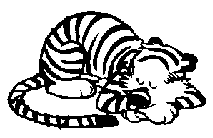 Sprite suggested the idea of Hobbes greeting Calvin at the door in midair at high velocity." Hobbes, like a lot of cartoon animals, has some humanlike behaviours such as upright walking as well as talking and playing with Calvin, yet he maintains many feline characteristics such as pouncing and the love of not being human. Hobbes dual reality is a subject of "controversy" for the strip. Watterson does not intend for Hobbes to a doll that comes to life for Calvin nor a figment of Calvin's imagination. Hobbes appears through the perspecctive of whomever sees him. Calvin sees him as real, pouncing friend and thus he his, while the rest of the world sees him as a stuffed doll and so he is. Watterson makes certain that the issue is never resolved, by showing two versions of reality and it making sense demending on one's point of view.
Sprite suggested the idea of Hobbes greeting Calvin at the door in midair at high velocity." Hobbes, like a lot of cartoon animals, has some humanlike behaviours such as upright walking as well as talking and playing with Calvin, yet he maintains many feline characteristics such as pouncing and the love of not being human. Hobbes dual reality is a subject of "controversy" for the strip. Watterson does not intend for Hobbes to a doll that comes to life for Calvin nor a figment of Calvin's imagination. Hobbes appears through the perspecctive of whomever sees him. Calvin sees him as real, pouncing friend and thus he his, while the rest of the world sees him as a stuffed doll and so he is. Watterson makes certain that the issue is never resolved, by showing two versions of reality and it making sense demending on one's point of view.
Calvin's Parents: Forever nameless as anything
other than "Mom" and "Dad," they are the adult influences on Calvin's life.  Calvin's mum seems at constant odds with her son due to his unwillingness to attend school, his ability to get into trouble and his destructive nature. She is often seen as exasperated and depressed at all of Calvin's maladjustments and is subject to numerous conferences with Calvin's school as well as Calvin's other school nuances. Being primarily responsible for putting Calvin to bed, much of Calvin's mum's energy is actually spent keeping him there and then attempting to get him back up in the
Calvin's mum seems at constant odds with her son due to his unwillingness to attend school, his ability to get into trouble and his destructive nature. She is often seen as exasperated and depressed at all of Calvin's maladjustments and is subject to numerous conferences with Calvin's school as well as Calvin's other school nuances. Being primarily responsible for putting Calvin to bed, much of Calvin's mum's energy is actually spent keeping him there and then attempting to get him back up in the  morning. School mornings often provide an endless array of mother-son angst. Calvin's dad, a patent attorney, is part satire of Watterson's own father, with many of Calvin's character-building experiences coming from Watterson's childhood. Calvin's dad often feeds him crazy and humourous information about anything from how the sunsets to how bridges are built. Calvin's dad often reminds me of my mother who would tell me crazy stories like she found me as a toddler wandering around a restaurant parking lot, and would mouthe words at me to make me think I had temporarily gone deaf. Though they can be sarcastic and impatient with their son, Calvin's parents are portrayed as very loving without the addition of sanctimonious sap seen in many other family strips. In essence, they are very realistic if one thinks about what it would be like to have a son like Calvin.
morning. School mornings often provide an endless array of mother-son angst. Calvin's dad, a patent attorney, is part satire of Watterson's own father, with many of Calvin's character-building experiences coming from Watterson's childhood. Calvin's dad often feeds him crazy and humourous information about anything from how the sunsets to how bridges are built. Calvin's dad often reminds me of my mother who would tell me crazy stories like she found me as a toddler wandering around a restaurant parking lot, and would mouthe words at me to make me think I had temporarily gone deaf. Though they can be sarcastic and impatient with their son, Calvin's parents are portrayed as very loving without the addition of sanctimonious sap seen in many other family strips. In essence, they are very realistic if one thinks about what it would be like to have a son like Calvin.
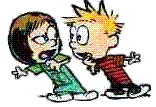 Susie Derkins: Susie, whose last name comes from a nickname for Watterson's wife's family's beagle, "is earnest, serious, and smart," and based on Watterson's wife. She was introduced very early on in the series as a new girl in Calvin's class upon whom Hobbes, being a good best friend, notes Calvin's slight crush.
Susie Derkins: Susie, whose last name comes from a nickname for Watterson's wife's family's beagle, "is earnest, serious, and smart," and based on Watterson's wife. She was introduced very early on in the series as a new girl in Calvin's class upon whom Hobbes, being a good best friend, notes Calvin's slight crush.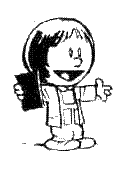 Instead of expressing anything of the sort, Calvin reverts to a typically six-year-old behaviour and calls her names and throws hailstorms of snowballs at her. She and Calvin shared a love-hate relationship toward the beginning of the strip, however later on, it was more or less hate-hate. Calvin loves to annoy Susie by being truly weird, which not only annoys but offsets Susie as well, and in turn, Calvin behaves even weirder toward her. Calvin reveals many times throughout the series that he simply does not understand girls and that which he did understand was that they were inherently "GROSS," and later created a club whose goal was rid the world of such entities.
Instead of expressing anything of the sort, Calvin reverts to a typically six-year-old behaviour and calls her names and throws hailstorms of snowballs at her. She and Calvin shared a love-hate relationship toward the beginning of the strip, however later on, it was more or less hate-hate. Calvin loves to annoy Susie by being truly weird, which not only annoys but offsets Susie as well, and in turn, Calvin behaves even weirder toward her. Calvin reveals many times throughout the series that he simply does not understand girls and that which he did understand was that they were inherently "GROSS," and later created a club whose goal was rid the world of such entities.
 Rosalyn: A twenty-something college student with a low tolerance for Calvin's antics, Rosalyn is probably the only person Calvin fears. Her relationship with Calvin is quite one dimensional in that they despise one another. From locking her out of the house, to flushing her notes the night before an exam, Calvin did everything he could to make her life miserable. As compensation for dealing with Calvin's incorrigibility, Rosalyn plugs as much money out of his parents as possible, and no one could possibly blame her. Rosalyn's racket is due to the fact that she is only sitter in the area willing to watch Calvin.
Rosalyn: A twenty-something college student with a low tolerance for Calvin's antics, Rosalyn is probably the only person Calvin fears. Her relationship with Calvin is quite one dimensional in that they despise one another. From locking her out of the house, to flushing her notes the night before an exam, Calvin did everything he could to make her life miserable. As compensation for dealing with Calvin's incorrigibility, Rosalyn plugs as much money out of his parents as possible, and no one could possibly blame her. Rosalyn's racket is due to the fact that she is only sitter in the area willing to watch Calvin. 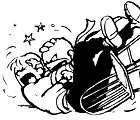 Without her, Calvin's parents would never have a night out for themselves and because of this, she can demand advances and constant pay raises. She is the only one who holds the power of some kind of control over Calvin, and that is really saying something.
Without her, Calvin's parents would never have a night out for themselves and because of this, she can demand advances and constant pay raises. She is the only one who holds the power of some kind of control over Calvin, and that is really saying something.
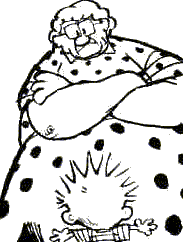 Miss Wormwood: Miss Wormwood is named after the apprentice devil in C.S. Lewis' The Screwtape Letters and is clearly less than a year away from retirement. However, she has to deal with one troublesome six-year-old before she can reach her golden years. Most likely because of Calvin, she smokes more than a pack of cigarettes a day and takes a number of medications in conjunction (probably to ease her upset stomach) due to Calvin's rambunctious classroom antics. From random classroom outbursts, to running away from school; from absurd school assignments, to Calvin's insistence of pushing the limit on what is "normal" for a first grader's demeanor, Miss Wormwood has seen it all.
Miss Wormwood: Miss Wormwood is named after the apprentice devil in C.S. Lewis' The Screwtape Letters and is clearly less than a year away from retirement. However, she has to deal with one troublesome six-year-old before she can reach her golden years. Most likely because of Calvin, she smokes more than a pack of cigarettes a day and takes a number of medications in conjunction (probably to ease her upset stomach) due to Calvin's rambunctious classroom antics. From random classroom outbursts, to running away from school; from absurd school assignments, to Calvin's insistence of pushing the limit on what is "normal" for a first grader's demeanor, Miss Wormwood has seen it all.
 Moe: Moe is a typical bully: a great lummox who is mean for absolutely no reason and takes some absurd joy in picking on those who are smaller than he. Moe has clearly been left back in school for a year or two and even shaves as a first grader. He is also the one aspect of the comic that I never really liked. I always felt Calvin's constant bullying by Moe took away from the whimsical nature of the strip and pulled me into a reality I did not want to discover. Having never been bullied in my own childhood, I cannot say what it feels like for sure, but I never liked it when the hero of the series experienced it. Moe is, in Watterson's words, "every jerk I've ever known. He's big, dumb, ugly, and cruel. I remember school being full of idiots like Moe. I think they spawn on damp locker room floors."
Moe: Moe is a typical bully: a great lummox who is mean for absolutely no reason and takes some absurd joy in picking on those who are smaller than he. Moe has clearly been left back in school for a year or two and even shaves as a first grader. He is also the one aspect of the comic that I never really liked. I always felt Calvin's constant bullying by Moe took away from the whimsical nature of the strip and pulled me into a reality I did not want to discover. Having never been bullied in my own childhood, I cannot say what it feels like for sure, but I never liked it when the hero of the series experienced it. Moe is, in Watterson's words, "every jerk I've ever known. He's big, dumb, ugly, and cruel. I remember school being full of idiots like Moe. I think they spawn on damp locker room floors."
Spaceman Spiff: Originally created as a project for one of Watterson's high school classes, Spaceman Spiff is one of Calvin's alter egos and is used as a sort of escape from Calvin's reality. Spiff, a constant explorer, roams the galaxy constantly being kidnapped by alien monsters and avoiding them on new and distinctive extraterrestrial worlds. Set with an elaborate costume, Spaceman Spiff is Calvin's presence during the most difficult of situations. What I 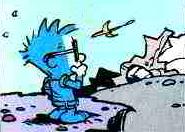 have always loved about the Spiff stories is how they are expressively narrated and the artwork is so beautiful, especially once Watterson had the layout restrictions lifted. What I remember most about reading this series in newspapers as a child, was how brilliant it looked to have a stunningly created Sunday Spiff story next to whatever else happened to be on the front page of the comics section. Spaceman Spiff's new worlds and the creatures that inhabited them show Watterson's brilliance as an artsist.
have always loved about the Spiff stories is how they are expressively narrated and the artwork is so beautiful, especially once Watterson had the layout restrictions lifted. What I remember most about reading this series in newspapers as a child, was how brilliant it looked to have a stunningly created Sunday Spiff story next to whatever else happened to be on the front page of the comics section. Spaceman Spiff's new worlds and the creatures that inhabited them show Watterson's brilliance as an artsist.
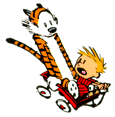 Calvin's Wagon and Toboggan: Calvin's wagon and his toboggan are used when he becomes somewhat philosophical. It has always been amusing to read about life's decisions or human vulnerability while the duo race through panels, off of ledges into the air, often crashing into piles of snow, pools of water or simply on the ground. Calvin's wagon and toboggan are symbols of youth and innocence set against an often idealistic or even pragmatic subject matter. They both also lead the duo into the vast woods around Calvin's house, a forest where they can be themselves and hold the most interesting and surprising of conversations. However, sometimes it is just funny to watch them crash...
Calvin's Wagon and Toboggan: Calvin's wagon and his toboggan are used when he becomes somewhat philosophical. It has always been amusing to read about life's decisions or human vulnerability while the duo race through panels, off of ledges into the air, often crashing into piles of snow, pools of water or simply on the ground. Calvin's wagon and toboggan are symbols of youth and innocence set against an often idealistic or even pragmatic subject matter. They both also lead the duo into the vast woods around Calvin's house, a forest where they can be themselves and hold the most interesting and surprising of conversations. However, sometimes it is just funny to watch them crash...
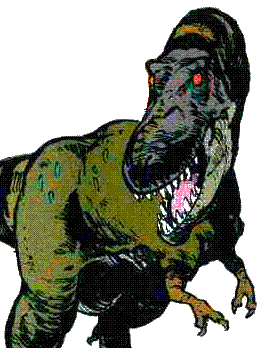 Dinosaurs: The dinosaurs in Calvin and Hobbes are among the most innovative and surreal aspects of the series. In the very early strips, they appear very comical and look like something clearly drawn out of the artist's memory, but the later depictions show the research and detail that went into making the creatures an intricate part of the series. Calvin loves dinosaurs and often whimsically sees himself as a large, graceful flying Pteradactyl or rampaging Tyrannosaur to depart from his boring reality. In the later strips, the dinosaurs look quite realistic and when set against Watterson's fantastic poetry, one cannot help, but feel for Calvin's love of the extinct creatures.
Dinosaurs: The dinosaurs in Calvin and Hobbes are among the most innovative and surreal aspects of the series. In the very early strips, they appear very comical and look like something clearly drawn out of the artist's memory, but the later depictions show the research and detail that went into making the creatures an intricate part of the series. Calvin loves dinosaurs and often whimsically sees himself as a large, graceful flying Pteradactyl or rampaging Tyrannosaur to depart from his boring reality. In the later strips, the dinosaurs look quite realistic and when set against Watterson's fantastic poetry, one cannot help, but feel for Calvin's love of the extinct creatures.
 Tracer Bullet: The Tracer Bullet stories are created specifically as a cliche with a very dramatic flair. The Tracer Bullet character appears as another of Calvin's alter egos, often when he is attempting to either avoid trouble or uncover some "secret." Watterson says in the Tenth Anniversary Book, "Tracer Bullet stories extremely time-consuming to write, so I don't attempt them often. I'm not at all familiar with film noir or detective novels, so these are just spoofs on the cliches of the genre. Cartoonists don't use black much anymore (the eye, being lazy, is attracted to empty white space, especially when the panels are so small), and we miss some dramatic possibilities that way."
Tracer Bullet: The Tracer Bullet stories are created specifically as a cliche with a very dramatic flair. The Tracer Bullet character appears as another of Calvin's alter egos, often when he is attempting to either avoid trouble or uncover some "secret." Watterson says in the Tenth Anniversary Book, "Tracer Bullet stories extremely time-consuming to write, so I don't attempt them often. I'm not at all familiar with film noir or detective novels, so these are just spoofs on the cliches of the genre. Cartoonists don't use black much anymore (the eye, being lazy, is attracted to empty white space, especially when the panels are so small), and we miss some dramatic possibilities that way."
GROSS: The Get Rid Of Slimy girlS club has just two members, a dictator for life and a head tiger, and only has one target, Susie Derkins, but it is highly effective in the annoyance and irritation of the target through use of hostage taking and general mischief making. GROSS is not a lucrative or constructive gentlemen's club, but it has been proven necessary over the years.
Calvinball: The only rule is that you can't play the same way twice.